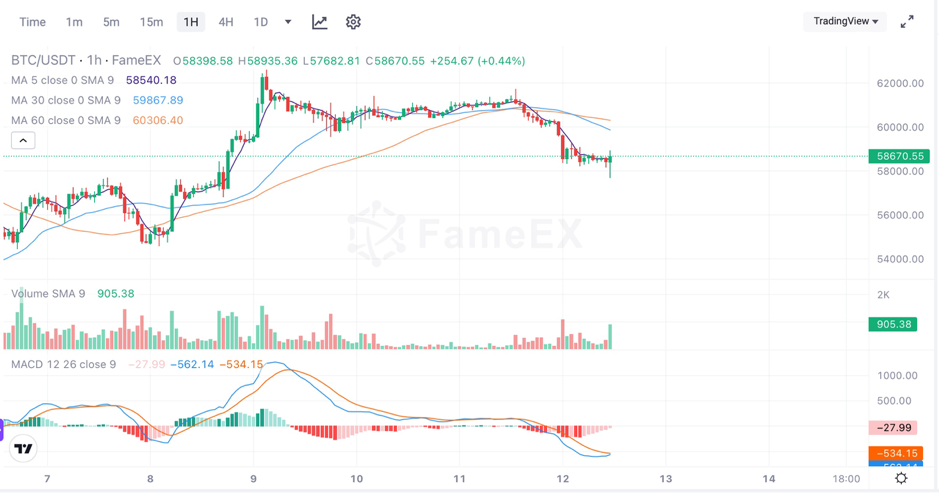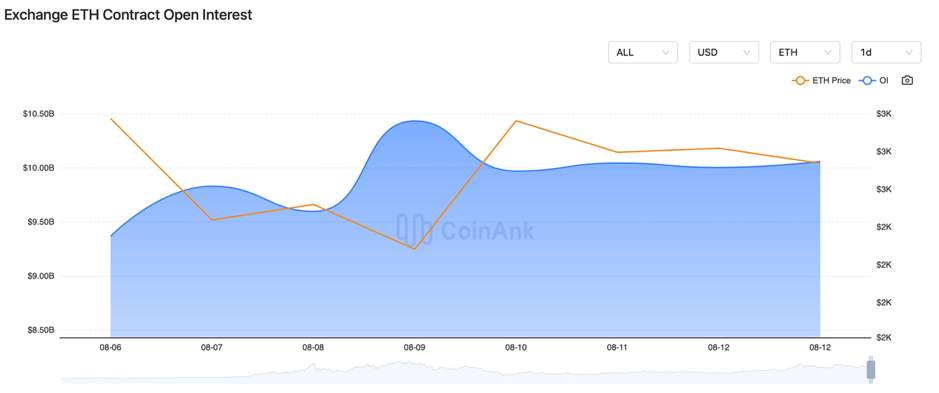FameEX Weekly Market Trend | August 12, 2024
2024-08-12 11:25:00
1. BTC Market Trend
From August 8 to August 11, the BTC spot price swung from $54,520.6 to $62,573.73, a 14.77% range. In the past four days, key statements from the Federal Reserve (Fed) were as follows:
1) On August 8, former New York Fed President Dudley suggested that the Fed might cut rates by 25 or 50 basis points in September.
2) On August 9, Fed’s Schmidt stated that a rate cut would be appropriate if inflation remains low.
3) On August 10, Fed’s Collins mentioned that if the data meets expectations, it would be appropriate to “soon” start easing policies.
4) On August 11, Fed Governor Bowman highlighted the upward risk of inflation and the continued strength in the labor market, indicating a cautious stance in the September meeting.
Recent key information on the Middle East situation:
On August 8, Hezbollah announced that it used Katyusha rockets, heavy artillery, and guided weapons to attack several Israeli military targets. That evening, the Israeli security cabinet held a meeting in the underground command center of the Israel Defense Forces headquarters in Tel Aviv to discuss how to respond to potential attacks from Iran and Hezbollah. According to Channel 12 of Israeli television, the security cabinet granted the military full freedom of action and instructed it to be prepared for preemptive strikes before any potential response from Iran or Hezbollah. The Israel Defense Forces prepared for a significant response, with potential targets extending beyond Lebanon. Scenarios include rocket launches and invasions from land and sea. Reports also indicated that Israel aims to signal its readiness for a potential escalation into full-scale war.
On August 9, twelve U.S. F-22 stealth fighters arrived in the Middle East, and the U.S. threatened to seek regime change in Iran if Israel were attacked. Both Iran and Hezbollah are believed to be penetrated by Israeli intelligence, with Iran still wanting to retaliate against Israel but unable to sustain a larger-scale war.
On August 9, Israel struck a Syrian airbase reportedly housing Russian troops. The Chief of Staff of the Syrian Armed Forces made a secret visit to Iran to strengthen bilateral relations and is said to have approved attacks on Israel from Syrian territory. Israel plans to send a negotiation team to finalize the details of a ceasefire and personnel exchange agreement for Gaza.
On August 10, an advisor to Iranian Supreme Leader Khamenei stated that preparations are underway to impose severe punishment on the Israeli regime.
As of August 10, since the outbreak of the current Israel-Gaza conflict, 168 journalists have been reported killed in Gaza.
The White House announced that a ceasefire meeting for Gaza will take place on August 15 in Doha or Cairo.
French President Macron held talks with the Emir of Qatar, reiterating calls for a ceasefire in Gaza, stating that France will cooperate with the UN Interim Force in Lebanon to ensure stability in Lebanon.
On August 11, Iran’s Acting Foreign Minister stated: “We will take ‘legal and decisive’ action against Israel.” According to the Islamic Republic News Agency, the Iranian Revolutionary Guard held military exercises in western Iran.
On August 9, the Fed is nearing the end of its balance sheet reduction, but the actual end date depends on interest rate cuts and financing market pressures. Decision-makers have suggested completing the reduction of U.S. Treasury holdings by the end of the year. Still, many on Wall Street believe that quantitative tightening is unlikely to end suddenly. However, recent weak economic data and liquidity pressure risks cast uncertainty on the outlook. “If the Fed intends to stimulate the economy, it may stop the balance sheet reduction,” wrote Bank of America strategists Mark Cabana and Katie Craig in a client report. “If the Fed’s goal is to normalize monetary policy, the balance sheet reduction can continue.”
Increasing signs suggest that economic growth is slowing faster than expected a few weeks ago, leading to a significant rise in global bonds as traders bet that the Fed and other central banks will become more aggressive in rate cuts. Morgan Stanley analysts wrote, “Two possible drivers might lead the Fed to end balance sheet reduction early: one is a depletion of liquidity in the money markets, and the other is a U.S. economic recession. However, we believe both are unlikely to occur.”

During our discussions with users, we found that many do not have a structured trading system. The following advice comes from a seasoned trader with over ten years of experience in various secondary market assets. The goal is to help you build a trading system suited to your current level and reduce unnecessary financial waste: Successful trading = 20% market analysis + 20% capital management + 60% emotional control. In centralized exchanges (CEX), the difficulty of trading is ranked as follows: the BTC spot trading is the easiest, followed by the spot trading of other top 20 cryptocurrencies by market capitalization, and then altcoins. The difficulty increases with the BTC futures, other major coin futures, and altcoin futures.
Regarding leverage, the correct approach to futures trading is to start with 1x leverage and gradually increase to 20x or higher. Many users who are new to futures trading jump straight to 10x or even 100x leverage are essentially gambling and not improving their real trading skills. You should increase your leverage in steps, such as 1x, 3x, 6x, 9x, 12x, 15x, 18x, and 20x times, similar to progressing through levels in a game. Only when you achieve good results at your current level should you move to the next.
In the beginning, it is advised to only use 1x leverage for short positions. Trading spot is equivalent to placing a 1x leveraged long futures position. Only attempt higher leverage when your overall win rate (profit after deducting trading fees) reaches above 80%. Each level of leverage represents a true increase in your trading ability, allowing you to test the highest leverage you can manage. The difficulty between different leverage levels is not merely a matter of arithmetic differences; for instance, 9x leverage is significantly more challenging than 6x leverage.
Leverage levels are not fixed and should be adjusted based on market conditions. Generally, trading difficulty in a sideways market, especially a narrow range, is greater than in a trending market. If you can handle 6x leverage in normal conditions, you might increase it to 9x during a clear trend. A trending market should last at least one hour, and the longer the trend persists (based on common time frames like 4-hour, daily, weekly, or monthly charts), the better the results.
Capital management should also be gradual. Determine the proportion of your total assets (or company assets) that can be invested in cryptocurrencies, and then divide your total account funds into 1,000 parts or another suitable number. For example, with $100,000 divided into 1,000 parts of $100 each, gradually increase your trade size (1, 5, 20, 100) as your trading skills improve. Only attempt larger trades when your overall win rate exceeds 80%. It’s more important to progress through the game gradually rather than rushing for large profits, creating a positive feedback loop.
Top global traders in fields like cryptocurrencies, futures, forex, and stocks can achieve relatively stable returns in any market condition. Finally, focus on trading in a specific domain where you have invested the most effort recently. Traders who focus exclusively on cryptocurrencies will likely achieve higher returns than those who trade both cryptocurrencies and U.S. stocks at the same level.
From August 12 to August 14, sell orders for the ETH spot at $4,700 and buy orders at $1,850, as well as sell orders for the BTC spot at $72,500, $77,500, and $92,000, and buy orders at $42,950, can still be kept.
2. Perpetual Futures
In general, the 7-day cumulative funding rates for the popular coins across major exchanges are negative, indicating that short leverages are relatively high.

In the past three days, the open interest in both BTC and ETH contracts has slowly increased.
Exchange BTC Contract Open Interest:

Exchange ETH Contract Open Interest:

Note: All the above information is provided for reference purposes only and should not be construed as specific investment advice.
3. Industry Roundup
1) On August 8, the number of initial jobless claims in the U.S. for the week ending August 3 was 233,000, below the expected 240,000, marking the largest decline in nearly a year and easing recession concerns.
2) On August 8, the Bank of Japan’s summary of opinions from its board members indicated that a small rate hike would not produce a tightening effect. Japanese Finance Minister Shunichi Suzuki noted that while the stock market’s volatility is being closely monitored, no immediate actions are planned.
3) On August 8, the Bank of Canada’s meeting minutes revealed that members agreed that the possibility of rate cuts would increase if inflation continues to ease.
4) On August 8, Reserve Bank of Australia Chair Philip Lowe expressed caution regarding inflation risks, stating that interest rates would be increased if necessary. Based on current information, a rapid decrease in rates is not anticipated.
5) On August 8, the U.S. Democratic Party launched the “Crypto for Harris” campaign to counter Trump’s crypto initiatives.
6) On August 8, the UK’s Financial Conduct Authority (FCA) issued new guidelines on cryptocurrency advertising compliance. Since October of the previous year, the FCA has issued over 1,000 warnings to crypto firms.
7) On August 8, market sources reported that the Central Bank of the Philippines has lifted its ban on establishing digital banks.
8) On August 8, Brazilian authorities dismantled the largest drug trafficking organization in Latin America, FCC, which was involved in crypto money laundering. The Brazilian Securities and Exchange Commission approved the first Solana spot ETF.
9) On August 8, a U.S. judge officially approved a $12.7 billion settlement agreement between FTX, Alameda, and the CFTC. Another judge ruled that Ripple must pay a $125 million fine in the SEC lawsuit, but trading cryptocurrencies remains legal.
10) On August 9, the White House and Harris’ advisors consulted with cryptocurrency industry executives but made no commitments. Sources revealed that the U.S. plans to establish a Bitcoin tax-free zone to promote digital economic development.
11) On August 9, the Fed instructed crypto-friendly bank Customers Bank to limit risk exposure from crypto clients.
12) On August 9, the assets of Ruja Ignatova, known as the “Crypto Queen” from OneCoin, were frozen by a UK court.
13) On August 9, Hong Kong Customs dismantled a group using multiple shell companies for cryptocurrency money laundering, with an involved amount of HKD 1.5 billion. A Hong Kong legislator announced plans to strengthen digital asset regulation in the next 18 months.
14) On August 9, China’s July CPI year-on-year rate was 0.5%, higher than the expected 0.3% and up from 0.2% previously. The National Bureau of Statistics of China reported that pork prices rose by 2.0%, contributing approximately 0.03 percentage points to the month-over-month CPI increase.
15) On August 9, Solana developers, validators, and client teams collaborated to fix critical vulnerabilities. The crypto liquidity fund Asymmetric Financial made substantial bets on Solana.
16) On August 9, Kazakhstan’s anti-money laundering agency prevented illegal cryptocurrency transactions totaling $75.4 million.
17) On August 10, the Fed announced the preliminary schedule for FOMC meetings through January 2027. Gemini co-founder noted that the Fed is controlling crypto companies’ access to banking services.
18) On August 10, the IRS released a new draft of the crypto tax form, no longer requiring wallet addresses and transaction IDs, and is seeking public comments.
19) On August 10, as of August 9, the supply of stablecoins on the Solana chain grew by 156% year-on-year, and the network’s Total Value Locked (TVL) increased tenfold.
20) On August 11, U.S. Vice President Harris announced plans to introduce an economic policy platform next week, opposing Trump’s views on the Fed’s independence.
21) On August 11, Peru released regulations for Virtual Asset Service Providers (VASPs) to strengthen anti-money laundering and anti-terrorism financing requirements.
22) On August 11, Thailand launched a regulatory sandbox to test cryptocurrency innovations and services.
23) On August 11, according to Dune panel data, only the memecoin sector has seen gains in the past 90 days, while AI and blockchain gaming sectors have fallen by over 60%.
24) On August 11, next week’s releases include the U.S. NFIB Small Business Confidence Index for July and July PPI year-on-year and month-on-month rates on Tuesday; the U.S. July CPI year-on-year and month-on-month rates (both not seasonally adjusted and seasonally adjusted core CPI) on Wednesday; and initial jobless claims for the week ending August 10 on Thursday.
25) On August 11, a report indicated that significant unlocks are expected next week for APT, SAND, ARB, STRK, APE, CYBER, ENA, RENDER, ASTR, NYM, EUL, and FORT.
Disclaimer: FameEX makes no representations on the accuracy or suitability of any official statements made by the exchange regarding the data in this area or any related financial advice.